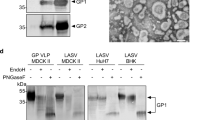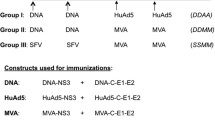Abstract
A 12.4-kDa peptide, corresponding to the entire ORF3 protein of hepatitis E virus (HEV), derived from human HEV genotype 4 and expressed in Escherichia coli as a fusion protein with a 17.5-kDa fragment of interleukin (IL)-1β at the N-terminus, was recognized by HEV-reactive sera. Eight monkeys were immunized with the purified peptide, and seven were used as non-immunized controls. All 15 monkeys were challenged with HEV genotype 1 or 4. All control animals developed infection and hepatitis, and all but one vaccinated monkey became infected. Nevertheless, the vaccine was effective in reducing the virus titer and shortening the duration of viremia and fecal shedding. Furthermore, the vaccine provided some protection against hepatitis (1 of 2 monkeys in the two-dose regimen and 4 of 6 in the three-dose regimen did not develop severe hepatitis) compared to the controls. These results suggest that immunization with the bacterially expressed peptide may partially prevent experimental hepatitis, and even infection, in primates, following intravenous challenge with high doses of two HEV genotypes.



Similar content being viewed by others
References
Bi S, Lu J, Jiang L, Huang G, Pan H, Jiang Y, Zhang M, Shen X (2002) Preliminary evidence that a hepatitis E virus (HEV) ORF2 recombinant protein protects cynomolgus macaques against challenge with wild-type HEV. Zhonghua Shiyan He Linchuang Bingduxue Zazhi 16:31–32
Graff J, Torian U, Nguyen H, Emerson SU (2006) A bicistronic subgenomic mRNA encodes both the ORF2 and ORF3 proteins of hepatitis E virus. J Virol 80:5919–5926
Herremans M, Bakker J, Duizer E, Vennema H, Koopmans MPG (2007) Use of serological assays for diagnosis of hepatitis E virus genotype 1 and 3 infections in a setting of low endemicity. Clin Vaccine Immunol 14:562–568
Huang CC, Nguyen D, Fernandez J, Yun KY, Fry KE, Bradley DW, Tam AW, Reyes GR (1992) Molecular cloning and sequencing of the Mexico isolate of hepatitis E virus (HEV). Virology 191:550–558
Huang W, Zhang H, Harrison TJ, Lang S, Huang G, Wang Y (2008) Cross-protection of hepatitis E virus genotypes 1 and 4 in rhesus macaques. J Med Virol 80:824–832
Im SW, Zhang JZ, Zhuang H, Che XY, Zhu WF, Xu GM, Li K, Xia NS, Ng MH (2001) A bacterially expressed peptide prevents experimental infection of primates by the hepatitis E virus. Vaccine 19:3726–3732
Jameel S, Zafrullah M, Ozdener MH, Panda SK (1996) Expression in animal cells and characterization of the hepatitis E virus structural proteins. J Virol 70:207–216
Khudyakov YE, Favorov MO, Jue DL, Hine TK (1994) Fields HA (1994) Immunodominant antigenic regions in a structural protein of the hepatitis E virus. Virology 198:390–393
Krawczynski K (2007) Hepatitis E vaccine-ready for prime time? N Engl J Med 356:949–951
Li F, Riddell MA, Seow HF, Takeda N, Miyamura T, Anderson DA (2000) Recombinant subunit ORF2.1 antigen and induction of antibody against immunodominant epitopes in the hepatitis E virus capsid protein. J Med Virol 60:379–386
Li F, Torresi J, Locarnini SA, Zhuang H, Zhu W, Guo X, Anderson DA (1997) Amino-terminal epitopes are exposed when full-length open reading frame 2 of hepatitis E virus is expressed in Escherichia coli, but carboxy-terminal epitopes are masked. J Med Virol 52:289–300
Li F, Zhuang H, Kolivas S, Locarnini SA, Anderson DA (1994) Persistent and transient antibody responses to hepatitis E virus detected by western immunoblot using open reading frame 2 and 3 and glutathione S-transferase fusion proteins. J Clin Microbiol 32:2060–2066
Li SW, Zhang J, He ZQ, Ge SX, Gu Y, Lin J, Liu RS, Xia NS (2002) The study of aggregate of the ORF2 peptide of hepatitis E virus expressed in Escherichia coli. Sheng Wu Gong Cheng Xue Bao 18:463–467
Ma Y, Lin SQ, Gao Y, Li M, Luo WX, Zhang J, Xia NS (2003) Expression of ORF2 partial gene of hepatitis E virus in tomatoes and immunoactivity of expression products. World J Gastroenterol 9:2211–2215
Masuda J, Yano K, Tamada Y, Takii Y, Ito M, Omagari K, Kohno S (2005) Acute hepatitis E of a man who consumed wild boar meat prior to the onset of illness in Nagasaki, Japan. Hepatol Res 31:178–183
McAtee CP, Zhang Y, Yarbough PO, Fuerst TR, Stone KL, Samander S, Williams KR (1996) Purification and characterization of a recombinant hepatitis E protein vaccine candidate by liquid chromatography-mass spectrometry. J Chromatogr B Biomed Appl 685:91–104
Purcell RH, Nguyen H, Shapiro M, Engle RE, Govindarajan S, Blackwelder WC, Wong DC, Prieels JP, Emerson SU (2003) Pre-clinical immunogenicity and efficacy trial of a recombinant hepatitis E vaccine. Vaccine 21:2607–2615
Robinson RA, Burgess WH, Emerson SU, Leibowitz RS, Sosnovtseva SA, Tsarev S, Purcell RH (1998) Structural characterization of recombinant hepatitis E virus ORF2 proteins in baculovirus-infected insect cells. Protein Expr Purif 12:75–84
Ruan B, Zhuang H, Ma Y (1998) Dynamics of anti-HEV ORF2, ORF3, IgM and IgG in serial sera of patients with hepatitis E and their clinical significance. Zhonghua Yi Xue Za Zhi 78:498–500
Schlauder GG, Mushahwar IK (2001) Genetic heterogeneity of hepatitis E virus. J Med Virol 65:282–292
Shrestha MP, Scott RM, Joshi DM, Mammen PM, Thapa GB, Thapa N, Myint KSA, Fourneau M, Kuschner RA, Shrestha SK, David MP, Seriwatana J, Vaughn DW, Safary A, Endy TP, Innis BL (2007) Safety and efficacy of a recombinant hepatitis E vaccine. N Engl J Med 356:895–903
Skidmore S (2002) Overview of hepatitis E virus. Curr Infect Dis Rep 4:118–123
Stevenson P (2000) Nepal calls the shots in hepatitis E virus vaccine trial. Lancet 355:1623
Takahashi M, Yamada K, Hoshino Y, Takahashi H, Ichiyama K, Tanaka T, Okamoto H (2008) Monoclonal antibodies raised against the ORF3 protein of hepatitis E virus (HEV) can capture HEV particles in culture supernatant and serum but not those in feces. Arch Virol 153:1703–1713
Tam AW, Smith MM, Guerra ME, Huang CC, Bradley DW, Fry KE, Reyes GR (1991) Hepatitis E virus (HEV): molecular cloning and sequencing of the full-length viral genome. Virology 185:120–131
Tam AW, White R, Yarbough PO, Murphy BJ, McAtee CP, Lanford RE, Fuerst TR (1997) In vitro infection and replication of hepatitis E virus in primary cynomolgus macaque hepatocytes. Virology 238:94–1024
Tei S, Kitajima N, Takahashi K, Mishiro S (2003) Zoonotic transmission of hepatitis E virus from deer to human beings. Lancet 362:371–373
Tong YP, Bi SL, Jiang YZ, Zhan MY (2001) Intracellular expression of hepatitis E virus ORF2 protein in pichia pastoris and its purification. Bingdu Xuebao 17:34–37
Tong YP, Bi SL, Zhang MC, Lu J, Zhan MY (2000) Extracellular expression of hepatitis E virus ORF2 protein in pichia pastoris. Zhonghua Shiyan He Linchuangbing Duxue Zazhi 14:391–392
Tong YP, Lu J, Jian YZ, Bi SL, Zhan MY (2001) The application of recombinant HEV ORF2 protein expressed in yeast cells to the diagnosis of hepatitis E. Zhonghua Shiyan He Linchuang Bingduxue Zazhi 15:189–190
Tsarev SA, Tsareva TS, Emerson SU, Govindarajan S, Shapiro M, Gerin JL, Purcel RH (1997) Recombinant vaccine against hepatitis E: dose response and protection against heterologous challenge. Vaccine 15:1834–1838
Wang YC, Zhang HY, Ling R, Li HM, Harrison TJ (2000) Hepatitis E virus genotype 4 uses an alternative strategy for translation of open reading frames 2 and 3. J Gen Virol 81:1675–1686
Wang YC, Zhang HY, Xia NS, Peng G, Lan HY, Zhuang H, Zhu YH, Li SW, Tian KG, Gu WJ, Lin JX, Wu X, Li HM, Harrison TJ (2002) Prevalence, isolation, and partial sequence analysis of hepatitis E virus from domestic animals in China. J Med Virol 67:516–521
Xing L, Kato K, Li T, Takeda N, Miyamura T, Hammar L, Cheng RH (1999) Recombinant hepatitis E capsid protein self-assembles into a dual-domain T = 1 particle presenting native virus epitopes. Virology 265:35–45
Yarbough PO (1999) Hepatitis E virus. Advances in HEV biology and HEV vaccine approaches. Intervirology 42:179–184
Zhang J, Ge SX, Huang GY, Li SW, He ZQ, Wang YB, Zheng YJ, Gu Y, Ng MH, Xia NS (2003) Evaluation of antibody-based and nucleic acid-based assays for diagnosis of hepatitis E virus infection in a rhesus monkey model. J Med Virol 71:518–526
Zhang M, Emerson SU, Nguyen H, Engle RE, Govindarajan S, Gertin JL, Purcel RH (2001) Immunogenicity and protective efficacy of a vaccine prepared from 53 kDa truncated hepatitis E virus capsid protein expressed in insect cells. Vaccine 20:853–857
Zhang M, Yi Y, Zhan M, Liu C, Bi S (2002) Expression of thermal stable, soluble hepatitis E virus recombinant antigen. Zhonghua Shiyan He Linchuang Bingduxue Zazhi 16:20–22
Zhang M, Zhao H, Jiang Y (1999) Expression of hepatitis E virus structural gene in E. coli. Zhonghua Shiyan He Linchuang Bingduxue Zazhi 13:130–132
Zhao CY, Li Z, Yan BS, Harrison TJ, Guo XH, Zhang F, Yin J, Yan Y, Wang YC (2007) Comparison of real-time fluorescent RT-PCR and conventional RT-PCR for the detection of hepatitis E virus genotypes prevalent in China. J Med Virol 79:1966–1973
Acknowledgments
We thank Chuan Ji for assistance with the development of the enzyme immunoassays and Junsheng Cui for assistance with the preparation of vaccine. This study was supported by the “863” project (grant: 2006AA02Z453) from the Ministry of Science and Technology, China.
Author information
Authors and Affiliations
Corresponding author
Rights and permissions
About this article
Cite this article
Ma, H., Song, X., Harrison, T.J. et al. Immunogenicity and efficacy of a bacterially expressed HEV ORF3 peptide, assessed by experimental infection of primates. Arch Virol 154, 1641–1648 (2009). https://doi.org/10.1007/s00705-009-0496-4
Received:
Accepted:
Published:
Issue Date:
DOI: https://doi.org/10.1007/s00705-009-0496-4




